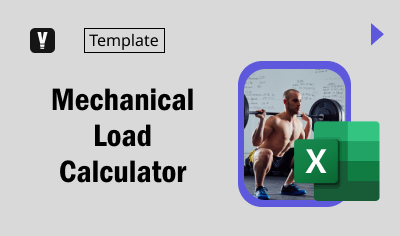18 de June de 2025
Unlock Peak Performance: How to Use Mechanical Load to Tailor Your Training Plan
Strength, power, endurance, these aren’t just buzzwords; they’re your athletes’ ultimate goals. But how do you move past generalized workouts and truly tailor training plans that deliver elite performance? The answer lies in mechanical load, the key to personalizing sessions, maximizing efficiency, and achieving specific training outcomes.
Mechanical load isn’t just about working harder; it’s about working smarter. By leveraging metrics like sets, reps, and load, you can design data-driven, precise workouts that boost performance without unnecessary strain. For strength and conditioning coaches, personal trainers, and university or high school teams, this marks the next step toward elevating athletes’ results.
This blog will guide you through:
- What mechanical load is and why it matters
- The key metrics to track and how they relate to your goals
- How to use a Mechanical Load Calculator to create goal-oriented training plans
- Pro tips to optimize mechanical load for improved training outcomes
What Is Mechanical Load and Why Does It Matter?
Simply put, mechanical load refers to the total stress placed on muscles during physical training. It’s calculated based on the combination of key training variables:
- Load (weight lifted)
- Volume (sets x reps)
- Intensity (load relative to an individual’s maximum capacity)
Mechanical load provides a quantifiable measure of the work being done by an athlete, making it an essential concept for fine-tuning training programs. Instead of relying solely on “feel” or generic routines, mechanical load allows coaches and trainers to:
- Measure progress with precision
- Prevent overtraining by controlling the workload
- Target specific adaptations, such as hypertrophy, endurance, or power
By mastering mechanical load, you elevate training from guesswork to science, ensuring that every minute spent in the weight room yields maximum results.
Key Metrics to Analyze Mechanical Load
Understanding how to manipulate and track mechanical load starts with these primary metrics:
1. Sets and Reps
The total number of sets and reps dictates the volume of work done. Higher-volume training tends to promote hypertrophy (muscle growth), while lower-volume, higher-intensity sessions are more effective for building strength and power.
2. Load (Weight)
Load is the amount of weight lifted during an exercise. Accurate load selection is critical for targeting specific adaptations:
- Strength requires near-maximal loads.
- Power development benefits from moderate loads that allow for velocity-based training.
- Endurance involves lighter loads and higher reps to build stamina.
Tracking and adjusting load ensures athletes are developing within their desired performance zone.
3. Time Under Tension (TUT)
This refers to the total time a muscle is under strain during a movement. Longer TUT is particularly beneficial for hypertrophy as it enhances muscular endurance.
Example:
- Strength Goal: 2–3 seconds per rep
- Hypertrophy Goal: 4–6 seconds per rep
- Power Goal: Explosive, fast reps with minimal TUT
4. Rest Intervals
The amount of rest between sets significantly impacts training adaptation. Short rest periods favor endurance, while longer rest support strength and power gains:
- Strength & Power: 2–5 minutes of rest
- Hypertrophy: 30 seconds to 1.5 minutes
- Endurance: 15–60 seconds
How to Use the Mechanical Load Calculator for Tailored Training Plans
A Mechanical Load Calculator simplifies the process of creating personalized training programs. It provides precise metrics based on individual data and training goals, eliminating guesswork. Here’s how to implement it into your strategy:
Step 1: Define Your Goals
Before inputting data, define the athlete’s primary goals:
- Strength to lift heavier
- Power to improve explosive movements
- Hypertrophy for muscle size
- Endurance for stamina and recovery
Step 2: Enter Key Data Points
The calculator requires fundamental metrics such as:
- 1RM (One-Rep Max) for specific lifts
- Desired training volume and intensity
- Individual factors such as age, training history, and recovery rate
Step 3: Generate a Plan
Based on the entered data, the calculator will:
- Provide optimal load recommendations for each exercise
- Suggest a rep and set schemes tailored to the goal
- Adjust rest intervals and tempo recommendations to enhance adaptations
Step 4: Monitor and Adjust
Tracking progress in real-time allows you to modify the plan as needed. For example:
- Increase the load when consistent progress is shown
- Adjust volume for periods of high fatigue or competition preparation
This ongoing adjustment ensures training aligns with the athlete’s evolving needs and capabilities.

Mechanical Load Calculator
Pro Tips to Optimize Mechanical Load for Success
To truly harness the power of mechanical load, keep these best practices in mind:
1. Periodize the Training Program
Breaking the training year into distinct phases, such as hypertrophy, strength, and power, ensures balanced progress and avoids plateaus. For example:
- Off-season might focus on high-volume (hypertrophy) work.
- Pre-season could transition to a strength and power emphasis.
2. Implement Velocity-Based Training (VBT)
For power-focused athletes, using tools to measure barbell velocity enables more precise load adjustments. This ensures athletes are always training with the optimal speed-to-load ratio for power.
3. Track Fatigue Levels
Fatigue isn’t the enemy; it’s a signal. By monitoring it, you can determine when to reduce workload to prevent overtraining. Tools like heart rate variability (HRV) trackers or subjective fatigue scales can complement mechanical load insights.
4. Tailor to Individual Needs
No two athletes are the same. Use the Mechanical Load Calculator to customize programs based on each individual’s body type, training experience, and performance goals.
Build Smarter Workouts with Precision Planning
Mechanical load is the linchpin of effective strength and conditioning programs. By understanding and using metrics such as sets, reps, load, and TUT, you can optimize training plans that deliver targeted results, be it strength, endurance, or explosive power.
And the best part? You don’t have to tackle it alone. The Mechanical Load Calculator transforms complex data into actionable insights, giving you the tools to craft personalized and efficient programs for every athlete.
Take your coaching game to the next level: Try the Mechanical Load Calculator now for free!
